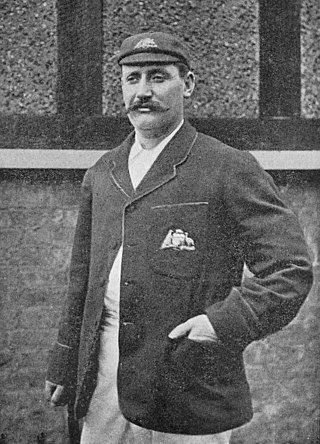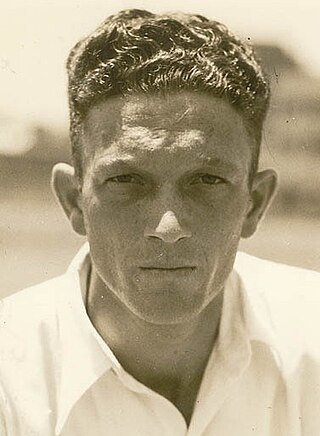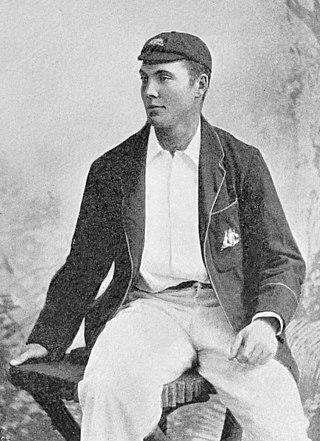Related Research Articles

David Clarence Boon is an Australian cricket match referee,former cricket commentator and international cricketer whose international playing career spanned the years 1984–1996. A right-handed batsman and a very occasional off-spin bowler,he played first-class cricket for both his home state Tasmania and English county side Durham. Boon was a part of the Australian team that won their first world title during the 1987 Cricket World Cup.

The Tasmania men's cricket team,nicknamed the Tigers,represents the Australian state of Tasmania in cricket. They compete annually in the Australian domestic senior men's cricket season,which consists of the first-class Sheffield Shield and the limited overs Matador BBQs One-Day Cup.

Clement"Clem" Hill was an Australian cricketer who played 49 Test matches as a specialist batsman between 1896 and 1912. He captained the Australian team in ten Tests,winning five and losing five. A prolific run scorer,Hill scored 3,412 runs in Test cricket—a world record at the time of his retirement—at an average of 39.21 per innings,including seven centuries. In 1902,Hill was the first batsman to make 1,000 Test runs in a calendar year,a feat that would not be repeated for 45 years. His innings of 365 scored against New South Wales for South Australia in 1900–01 was a Sheffield Shield record for 27 years. The South Australian Cricket Association named a grandstand at the Adelaide Oval in his honour in 2003 and he was inducted into the Australian Cricket Hall of Fame in 2005.Hill is regarded as one of the best batsman of his era.

Joseph Darling was an Australian cricketer who played 34 Test matches as a specialist batsman between 1894 and 1905. As captain,he led Australia in a total of 21 Tests,winning seven and losing four. In Test cricket,he scored 1,657 runs at an average of 28.56 per innings,including three centuries. Darling toured England four times with the Australian team—in 1896,1899,1902 and 1905;the last three tours as captain. He was captain of the Australian cricket team in England in 1902,widely recognised as one of the best teams in Australian cricket history.

George Henry Stevens Trott was an Australian cricketer who played 24 Test matches as an all-rounder between 1888 and 1898. Although Trott was a versatile batsman,spin bowler and outstanding fielder,"it is as a captain that he is best remembered,an understanding judge of human nature". After a period of some instability and ill discipline in Australian cricket,he was the first in a succession of assertive Australian captains that included Joe Darling,Monty Noble and Clem Hill,who restored the prestige of the Test team. Respected by teammates and opponents alike for his cricketing judgement,Trott was quick to pick up a weakness in opponents. A right-handed batsman,he was known for his sound defence and vigorous hitting. His slow leg-spin bowling was often able to deceive batsmen through subtle variations of pace and flight,but allowed opposition batsmen to score quickly.

Frank Edward Woolley was an English professional cricketer who played for Kent County Cricket Club between 1906 and 1938 and for the England cricket team. A genuine all-rounder,Woolley was a left-handed batsman and a left-arm bowler. He was an outstanding fielder close to the wicket and is the only non wicket-keeper to have held over 1,000 catches in a first-class career,whilst his total number of runs scored is the second highest of all time and his total number of wickets taken the 27th highest.

Donald Tallon was an Australian cricketer who played 21 Test matches as a wicket-keeper between 1946 and 1953. He was widely regarded by his contemporaries as Australia's finest ever wicket-keeper and one of the best in Test history,with an understated style,an ability to anticipate the flight,length and spin of the ball and an efficient stumping technique. Tallon toured England as part of Don Bradman's Invincibles of 1948 and was recognised as one of the Wisden Cricketers of the Year in 1949 for his performances during that season. During his Test career,Tallon made 58 dismissals comprising 50 catches and 8 stumpings.
Wayne Bentley Phillips is a former Australian cricketer who played in 27 Test matches and 48 One Day Internationals (ODIs) between 1982 and 1986 as a batsman and wicket-keeper. He played for South Australia between 1978 and 1991.

Robert William Taylor MBE is an English former cricketer who played as wicket-keeper for Derbyshire between 1961 and 1984 and for England between 1971 and 1984. He made 57 Test,and 639 first-class cricket appearances in total,taking 1,473 catches. The 2,069 victims across his entire career is the most of any wicket-keeper in first-class history. He is considered one of the world's most accomplished wicket-keepers. He made his first-class debut for Minor Counties against South Africa in 1960,having made his Staffordshire debut in 1958. He became Derbyshire's first choice wicket-keeper when George Dawkes sustained a career-ending injury. His final First Class appearance was at the Scarborough Festival in 1988. He remained first choice until his retirement except for a short period in 1964 when Laurie Johnson was tried as a batsman-wicketkeeper. He was a part of the English squad which finished as runners-up at the 1979 Cricket World Cup.

Arthur Fielder was an English professional cricketer who played as a fast bowler for Kent County Cricket Club and the England cricket team from 1900 to 1914. He played a major role in Kent's four County Championship wins in the years before World War I and toured Australia twice with the England team making six Test match appearances. He was chosen as one of Wisden's Cricketers of the Year in 1907.

Charles John Eady was an Australian sportsman,lawyer and politician.

Edwin James Kenneth Burn was an Australian cricketer who played in two Tests on the tour to England in 1890. Although unsuccessful at Test level,Burn is best known for being one of the most prolific batsmen in Tasmania at club level in the nineteenth century.

Douglas Thomas Ring was an Australian cricketer who played for Victoria and for Australia in 13 Test matches between 1948 and 1953. In 129 first-class cricket matches,he took 426 wickets bowling leg spin,and he had a top score of 145 runs,which was the only century of his career.
Australia won the 1930 Ashes series against England,winning two of the matches and losing one,with the other two tests drawn. The Australian tourists were captained by Bill Woodfull,while the home side were led by Percy Chapman,who was dropped in favour of Bob Wyatt in the final Test.

Timothy David Paine is an Australian former cricketer and a former captain of the Australia national cricket team in Test cricket. A right-handed batsman and a wicket-keeper,he played for the Tasmanian Tigers in Australian domestic cricket and was the captain of the Hobart Hurricanes before his selection for Australia in the 2017–18 Ashes series. During his time with Australia,Paine won the 2009 ICC Champions Trophy.

James Archibald "Snowy" Atkinson was an Australian rules footballer and first class cricketer.
The Australian cricket team toured the West Indies in the 1983–84 season to play a five-match Test series against the West Indies.

Thomas Alfred Tabart was a cricketer who played first-class cricket for Tasmania from 1897 until 1909.

Norman Dodds was an Australian first-class cricketer. He played for Tasmania from 1899 to 1908,and toured New Zealand with an Australian XI,but did not play Test cricket.
Kent County Cricket Club's 1909 season was the twentieth season in which the county club competed in the County Championship. Kent played 30 first-class cricket matches during the season,losing only two matches overall,and won their second championship title. They finished clearly ahead of second place Lancashire in the 1909 County Championship with the previous year's winners,Yorkshire,in third place.